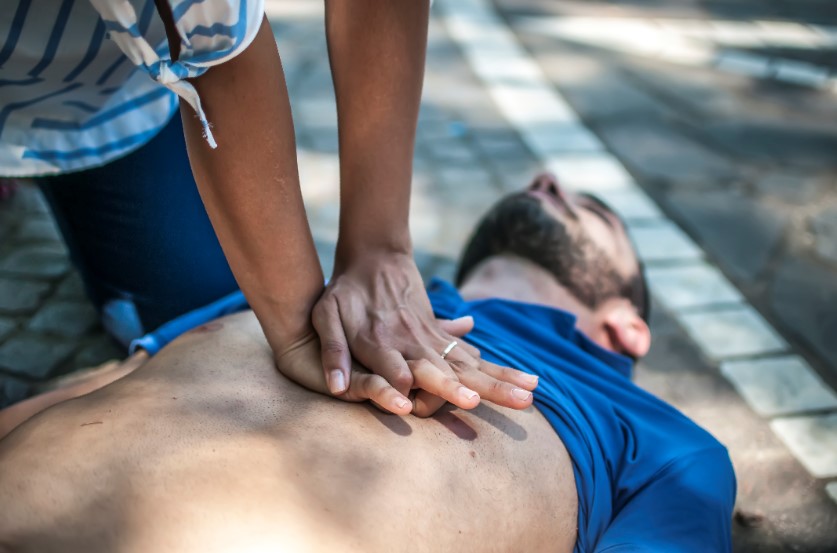Cardiopulmonary Resuscitation
Cardiopulmonary resuscitation (CPR) is a procedure performed to save someone’s life.
CPR can temporarily maintain brain function in a person whose heart and breathing have stopped, which can occur in such situations as a heart attack, cardiac arrest, electric shock, or blood loss.
CPR may also be needed if someone suffers a severe injury, near drowning, or a drug overdose.
CPR aims to ensure that someone who is not breathing or does not have a heartbeat still has oxygen delivered to the brain and other vital organs.
Without oxygen, a person’s life is in danger; permanent brain damage can occur within four minutes, and death can occur within eight to ten minutes.
WHEN SHOULD YOU PERFORM CPR?
It is usually necessary to perform CPR when someone is not breathing and lacks a detectable pulse or heartbeat.
It may also be required when someone is both unconscious and not breathing. CPR is often performed outside of a hospital.
Because of the importance of the situation, emergency medical support (911 in the United States) should be called immediately if the case involves a teen or adult.
If you are alone with a baby or child who is not breathing, you should perform CPR for two minutes before calling emergency medical services.
The emergency dispatcher can provide detailed instructions on performing CPR over the phone.
HOW DO YOU PERFORM CPR?
CPR for adults, children, and infants older than one month involves doing the following steps in order:
- compressing the chest
- clearing the airway
- checking for breathing
There are differences in what steps you should perform depending on whether or not you have had CPR training.
Organizations like the American Heart Association (AHA) suggest that untrained people should try CPR if someone is in distress instead of doing nothing.
Before beginning CPR on anyone, you should make sure that the surrounding area is safe.
If an adult, teen, or child seems to need CPR, shout “are you okay?” or tap the shoulder to see if that will make the person conscious again.
If it is a newborn, flick the baby’s foot to see if this action will bring the baby back to consciousness.
If the infant, child, teen, or adult lacks a heartbeat, you should also determine if an automated external defibrillator (AED) is available nearby.
An AED is a medical equipment that can evaluate the heart’s rhythm and deliver an electric shock to correct the rhythm as needed.
AEDs are fabricated to be easy to use and available in many buildings.
Untrained
If you are untrained, you should only perform chest compressions, which is known as hands-only CPR.
You should complete the following steps:
- If the person seems unconscious, check for any sign of consciousness by shaking or gently tapping the person. At this point, emergency medical services should be called if there is no response.
- The person should be placed on his or her back on a level surface unless the individual might have a neck or back injury, then he or she should not be moved.
- Next, chest compressions should be started. Kneel beside the person. Put one hand on the center of the chest between the nipples on the sternum. The other hand should be placed on top of the first hand and the fingers interlaced. You should push down firmly so that the chest is compressed by two inches. Using a quick up-and-down motion, you should push hard and aim for about 100 compressions per minute.
- Continue to perform CPR until breathing and circulation have returned or until emergency medical professionals reach the scene.
Trained
If you are trained in CPR, you should complete the following steps after calling emergency medical services:
- Perform 30 chest compressions.
- Move the person’s chin forward and tilt the head back. Open the mouth and use your finger to clear any debris found in the mouth.
- Put your ear to the person’s open mouth to check for airflow through the mouth or nose and see if the person’s chest shows signs of movement.
- If the person is not breathing, pinch the nose shut. Put your mouth over the person’s mouth, forming a seal. Breathe two breaths into the person so that the person’s chest rises. If the chest fails to rise, re-tilt the person’s head to ensure the tongue is not covering the windpipe, then try to give the person two breaths again.
- Alternate between giving the person 30 chest compressions and two breaths. This process should continue until the person breathes on his or her own or professional medical help arrives to take over.
Cardiopulmonary Resuscitation For Newborns
For newborns under one month old, the CPR steps are slightly different. Suppose a newborn has stopped breathing or gasping for air due to an accident, injury, or medical condition.
- Check the newborn for injuries to his or her head, neck, or back. Support the head and neck and turn the newborn on his or her back, keeping the body straight.
- Open the newborn’s airway by tilting his or her head back, lift his or her chin, and hold his or her mouth open. Remove anything that may be blocking his or her airway, such as food or a small toy, if possible. Hold his or her mouth open, take a breath, and seal your lips around his or her nose and mouth. Give two one-second breaths to the newborn.
- Perform 30 compressions. A chest compression involves putting two fingers on one hand between and just below his or her two nipples on the sternum. Using your two fingers, press down about 1.5 inches (4 centimeters). The compressions should be equal in strength, done quickly and hard, and only involve going up and down.
- Continue moving between two breaths and 30 compressions until emergency medical personnel arrive or the newborn responds to CPR.
WHAT PRECAUTIONS SHOULD I TAKE WHEN PERFORMING CPR?
When you perform CPR, you should ensure that you do not leave the person alone or provide food or drink.
You should avoid moving the person’s head or neck or using a pillow under the person’s head if there could be a neck or back injury.
You should also not perform CPR on a healthy person or someone who is breathing because it can cause damage to a heart that is beating.
When you perform CPR, there is a chance that you can cause bruising, broken ribs, damage to the person’s ribs or breastbone, or even internal organ damage.
However, this risk should not stop you from providing CPR to someone who needs it, even if you do not have CPR training.
WHAT SHOULD YOU KNOW ABOUT CPR TRAINING?
CPR training is inexpensive and widely available. The AHA offers CPR instruction for everyone, from the layperson to the medical professional.
Such classes are taught in various settings such as schools, workplaces, community centers, and healthcare-related spaces. CPR is also included in first aid training.
There is also an AHA self-directed program called CPR Anytime that takes about 20 minutes and can be ordered online. These CPR Anytime
Training Kits offer a quick overview and training for the average person to respond to a medical emergency with CPR.
Additionally, AHA has placed hands-only CPR training kiosks at certain American airports so travelers can learn how to perform this type of CPR in five minutes while waiting for their flights.
Resources
Websites
“CPR & First Aid.” American Heart Association. https://cpr.heart.org/AHAECC/CPRAndECC/UCM_473161_CPR-and-ECC.jsp?_requestid=131406 (accessed October 20, 2018).
“Cardiopulmonary resuscitation (CPR): First Aid.” Mayo Clinic. https://www.mayoclinic.org/first-aid/first-aid-cpr/basics/art-20056600 (accessed October 20, 2018).
“CPR Steps.” American Red Cross. https://www.redcross.org/take-a-class/cpr/performing-cpr/cpr-steps (accessed October 20, 2018).
“What is CPR?” American Red Cross. https://cpr.heart.org/AHAECC/CPRAndECC/AboutCPRECC/WhatIsCPR/UCM_499896_What-is-CPR.jsp (accessed October 20, 2018).









